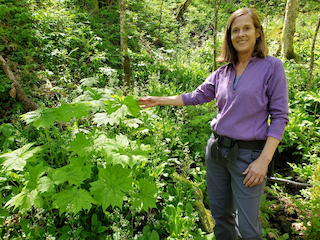

You couldn’t pick a more perfect month than May to head out on the trails to spot wildflowers. to help you learn more about them, Discover Life in America will host Wildflowers: Gems of the Smokies at the Sugarlands Visitor Center Friday, May 17, from 1–3 p.m.
Leading this free program will be wildflower expert Janet Rock, who studied biology with an emphasis on botany at Western Carolina University. Co-author of the popular GSMA field guide Wildflowers of the Smokies, Janet recently retired after 28 years as an NPS botanist. We asked her to tell us more about herself and the park’s amazing plant diversity.
Frances: How did you first become interested in wildflowers?
Janet: When I was growing up in northeastern Ohio, our Girl Scout troop members would challenge one another to identify all the plants we encountered on camping and hiking trips. My passion for wildflowers continued at Maryville College where my all-time favorite course was Plant Identification. Then I decided to pursue my masters in botany to fully immerse myself in the plant world.
Frances: What are some typical May blooming wildflowers that we might recognize?
Janet: This is one of the few national parks in North America that have over 1,700 species including the spectacular spring flora. There are so many examples depending on what your elevation is. May is a great time to see trillium at higher elevations, the start of flame azaleas, pink lady’s slippers, and Indian cucumber root.
Frances: Have any wildflower species been discovered through the work of Discover Life in America and the All Taxa Biodiversity Inventory?
Janet: Yes! At least 90 species of plants and a flowering shrub have been discovered that are new to the park. Most of these are native to the park but a few are non-native and need to be controlled by park vegetation management staff.
Frances: Why are plants important indicators for the sustainability of our planet?
Janet: Plants have many uses, from food to medicine to dye. They are important food sources for insects and other invertebrates as well. Without flowering plants, we wouldn’t have fruit, tubers or grains to eat.
Frances: Although people are often tempted to pick flowers, why should they not do this in the park?
Janet: Over-collection and poaching make it challenging for park plants to thrive and for botanists to study them. Our challenge is better educating visitors about how important it is not to pick flowers or plants in the park.
The plants in the park are protected, with a few special exceptions. For example, the Smokies recently finalized an agreement with the Eastern Band of Cherokee Indians to allow a very limited number of Cherokee tribal members, who must have permits, to collect a favorite edible spring green called Sochan (Rudbeckia laciniata).
Frances: What are some of the ways guests of the park can help our park’s wildflowers thrive?
Janet: Enjoy them at a distance! Do not compact the soil around the ones you intend to photograph. Also, park visitors should buy Wildflowers of the Smokies, which won an NPS Excellence in Interpretation award. For those wanting a bigger challenge, Wild Flowers of North Carolina and Wildflowers of Tennessee, the Ohio Valley and the Southern Appalachians are great resources.
Frances: What can folks look forward to when they attend your discussion on May 17?
Janet: The talk will emphasize plant communities and the wildflowers within. I plan to show slides and take a walk to emphasize the marvellous diversity of plants in the Smokies. I will show examples of wildflowers as well as blooming shrubs and trees. I hope the visitor will come to a greater understanding of how much topography and elevation play a role in plant diversity.
You can also plan to attend these upcoming Science at Sugarlands events*
June 21: Restoring fish to the Smokies most diverse stream with Pat Rakes, co-founder and director of Conservation Fisheries
July 19: The National Ecological Observatory Network (NEON) and its work in the Smokies with WP “Bill” Martin, field operations manager, NEON-Battelle Ecology
August 16: The grassy balds of the Great Smoky Mountains with Jesse Webster, NPS forester
September 20: Plant-soil microbiome interactions and the Chimney Tops fire with Kendall Beals, Ph.D. student, University of Tennessee
October 18: Lichens of the Smokies revealed with James Lendemer, assistant curator, New York Botanical Garden
*All events are FREE and held at Sugarlands Visitor Center, 1420 Fighting Creek Gap Road, Gatlinburg, TN, on Fridays from 1–3 p.m. Registration at dlia.org/sas is appreciated.
Subscribe to get the latest posts sent to your email.
The Great Smokies Welcome Center is located on U.S. 321 in Townsend, TN, 2 miles from the west entrance to Great Smoky Mountains National Park. Visitors can get information about things to see and do in and around the national park and shop from a wide selection of books, gifts, and other Smokies merchandise. Daily, weekly, and annual parking tags for the national park are also available.